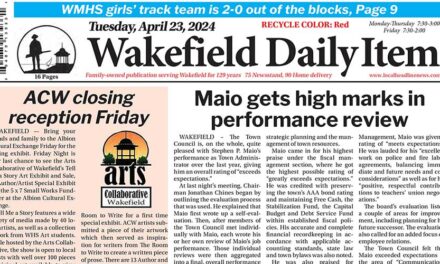Published in the March 13, 2017 edition.
WAKEFIELD — Emergency crews worked to right an 11,000-gallon gasoline tanker involved in an accident on Route 128 early Saturday morning.
No more than about 50 gallons of gas spilled out of the tanker.
The Wakefield Fire Department responded to Route 128 southbound near the North Avenue (exit 39) at approximately 12:10 a.m. on Saturday March 11. Reading firefighters were dispatched to the scene simultaneously, with both departments arriving within a minute or two of each other.
They discovered an 11,000-gallon gasoline tanker that had collided with two passenger vehicles. The collision resulted in the tanker truck striking the Jersey barrier on the southbound side just before the North Avenue bridge. Incredibly, there were only minor injuries to the truck driver and the occupants of the other vehicles.
The tanker of the vehicle separated from the front the tractor, rolling over the Jersey barrier and landing on the southbound side of the barrier, still partially attached to the truck. The tank remained intact; however, the gasoline was slowly dripping from all of the now upside-down manholes for each of the five compartments that made up the main tanker.
Wakefield Fire Captain Paul Pronco and Reading Fire Captain Mark Dwyer quickly set up a unified command post, combining their resources to bring the scene under control. Firefighters soon diked the nearby storm drains and spread an absorbent under each of the leaking manholes. They called for a full response from the Massachusetts District 2 Hazardous Materials Response Team, Mass. Department of Environmental Protection, Mass. Department of Transportation, The Massachusetts State Police and Coady’s tow company. Fire Chief Michael Sullivan arrived and assumed overall command of the incident.
Firefighters connected to a fire hydrant on Walker’s Brook Drive and laid fire hose up over the embankment and onto the highway. The Massachusetts Department of Fire Services arrived with a mobile command unit to house the incident command post and a rehabilitation unit to provide first responders a warm place to rehydrate and eat light snacks. The Department of Transportation brought sand to construct a dike around the tanker to contain any spilled gasoline and sanded the highway. Employees from Coady’s secured the disabled tanker and trailer with cables attached to their tow trucks to keep them from shifting as the cargo was unloaded.
The State Police closed both sides of the highway around the accident scene, diverting traffic on the northbound side to Quannapowitt Parkway and back onto the highway via the Route 129 rotary. The southbound traffic was diverted down the off and on ramps at North Avenue. Wakefield and Reading police assisted with this diversion of traffic off the highway.
Personnel from the District 2 Hazardous Materials Team set up operations to transfer the gasoline from the disabled tanker to another tanker brought to the scene by the owner of the trucking company. Attempts to off-load the fuel were first made through the tankers main valves, located beneath the tanker. These attempts proved unsuccessful and access holes were then drilled by specially trained hazardous materials team members equipped with self-contained breathing apparatus under the protection of firefighters manning hose lines. One hole was drilled into each of the five compartments and fuel was then pumped out of each compartment into the nearby tanker truck by the transport company’s employees. Dry ice was ordered and delivered under a State Police escort to the accident scene from a supply house in Roxbury. The dry ice was then placed into each tanker compartment to inert the atmosphere and prevent an ignition from occurring when the tanker was up-righted onto the roadway.
Employees from Coady’s tow company were then able to right the tanker and the truck, where they were then towed separately from the scene. The entire area was then cleaned of debris before the highway was re-opened on both sides shortly after 9 a.m. Less than 50 gallons of gasoline was released during the incident out of a potential total of more than 11,000 gallons present in the involved tanker.
Sullivan was extremely pleased with the high level of cooperation between all the state and local departments responding to the scene.
“Everyone involved at the incident worked well together and brought a dangerous emergency scene under control in an efficient and timely manner.”
The chief was particularly impressed, he said, by the expertise and guidance of the entire hazardous materials team, which is comprised entirely of firefighters from the metropolitan Boston area.
“They knew exactly how to handle the situation presented to them and proceeded to take the necessary steps to mitigate the emergency.” He gave credit to the Reading firefighters assisting at the scene, stating that “we simply could not have controlled the situation that quickly without their help.” The chief added, “We were extremely fortunate that no one was seriously injured during this incident and that is a credit to all of the personnel that responded to it.”




